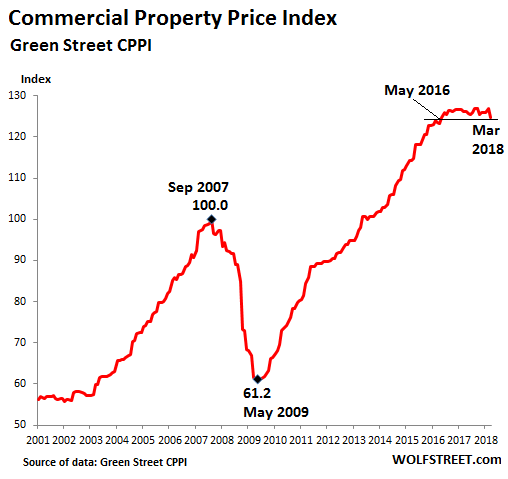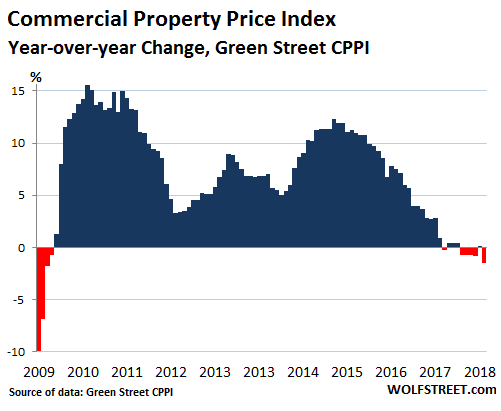Wolf Richter wolfstreet.com, www.amazon.com/author/wolfrichter
Leverage is why the Fed has been worried about the bubble in CRE.
Commercial real estate loans at banks in the US reached a record of $4.3 trillion. This amount is now 11% higher than it had been during the crazy peak of the prior commercial real estate bubble before it imploded during the Financial Crisis. In CRE, leverage is everything. Banks, particularly smaller regional banks that specialize in it, are on the hook.
Fed governors have pointed at CRE as one of the places where “elevated” prices threaten “financial stability” because of leverage and the connection to banks. CRE loans were in part responsible for the near-collapse of the financial system during the Financial Crisis, after CRE prices – the value of the collateral for those loans – turned down.
And now, these bubble prices have started to turn down once again.
Commercial real estate prices collapsed nearly 40% during the Financial Crisis, according to the Green Street Commercial Property Price Index (CPPI). Then prices more than doubled from the low in May 2009 and peaked in September 2017, when the index was 27% above the crazy peak of the prior bubble.
But since September 2017, the index has dropped 1.7%, including a 1% drop in March from February. It is now down 2.1% from March last year and back where it had been in May 2016.
This chart of the CPPI shows the phenomenal eight-year boom that has turned into a decline:

The chart below shows the percentage changes of the CPPI compared to the same month a year earlier going back to the Financial Crisis. Note the trend since 2015 of diminishing year-over-year price gains that turned into actual price declines late last year (red columns) and took a bigger dip in March:

“Over the past couple of years, commercial property pricing has cooled as investors take stock of record prices, slowing fundamentals, and higher Treasury rates,” the report said. “But the ho-hum performance in aggregate is a bit misleading….”
Turns out, one of the five major CRE sectors that make up the CPPI is red-hot, three are middling to declining, and one sector is plunging:
Industrial: Up 11% in March from a year ago. The sector includes warehouses and fulfillment centers, which are getting built, sold, and leased around the country as the retail industry, with Amazon at the top, is building up the infrastructure to handle the surge of e-commerce. This is the brick-and-mortar component of e-commerce.
Multi-family: The index for apartment properties has been flat for the past two years. It began to drop in 2017, but has recently ticked up a little, to where in March is was up 4% from the dip last year but remains below its peak two years ago.
Lodging: Hit by Airbnb, it took a big dive in 2015 and has not recovered since.
Office: The index dropped a steep 2% in March from February and is down 1% from March a year ago.
Retail: This is where the biggest issues are. The sector can be split into two categories – strip malls and malls.
- The sub-index for strip malls dropped 5% in March compared to March last year. It peaked at the end of 2016 and has since dropped 8%.
- The sub-index for Malls dropped 14% over the past 12 months, after plunging 5% in just one month, in March from February. It peaked at the end of 2016 and has since dropped 16%.
These price declines in the retail sector are starting to coalesce into a serious move – and it’s just the beginning. The mall sector will provide ample pain to lenders and holders of commercial mortgage-backed securities as this washes out over the next few years.
There are always winners and losers anytime there is a major structural shift. In terms of the shift from brick-and-mortar retail to e-commerce, CRE is benefiting in the industrial sector and is getting crushed in the mall sector. But this shift is happening within the overall downturn of CRE, after a most phenomenal seven-year price surge, funded by cheap loans that are now getting a lot more expensive.
March was also a busy month for the brick-and-mortar meltdown. And private equity firms were at the helm. Read… Brick & Mortar Retail Meltdown, March Update